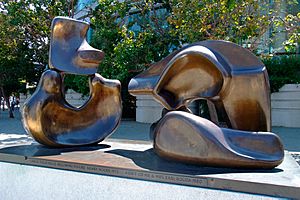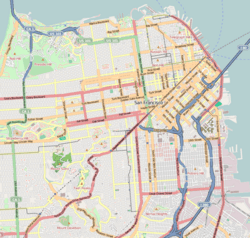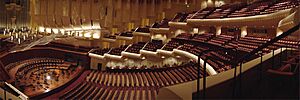Louise M. Davies Symphony Hall facts for kids
 |
|
| Address | 201 Van Ness Avenue San Francisco, California United States |
|---|---|
| Coordinates | 37°46′41″N 122°25′14″W / 37.777970°N 122.420646°W |
| Public transit | |
| Owner | San Francisco War Memorial and Performing Arts Center |
| Type | concert hall |
| Capacity | 2,743 |
| Construction | |
| Opened | 1980 |
| Architect | Skidmore, Owings & Merrill and Pietro Belluschi |
| Website | |
| sfwarmemorial.org | |
The Louise M. Davies Symphony Hall is a famous concert hall in San Francisco, California. It's part of a bigger place called the San Francisco War Memorial and Performing Arts Center. This hall has 2,743 seats and was finished in 1980. It cost about $28 million to build. Its main purpose was to give the San Francisco Symphony orchestra a special home of their own.
Before Davies Hall was built, the symphony shared another building, the War Memorial Opera House. They shared it with the San Francisco Opera and San Francisco Ballet. Having their own hall meant the symphony could perform all year long, much more often!
Contents
How Sound Works in the Hall

The hall was designed by Skidmore, Owings & Merrill and Pietro Belluschi. Special sound experts also helped. Its modern look is beautiful both inside and out. Over the stage, there's a "cloud" of panels that can move. These panels help bounce the sound around. They can be adjusted for different orchestra sizes and audiences.
There are also fabric banners around the hall. These banners can change how long sound echoes. This means the sound can be perfect for different types of music.
To make sure outside noises don't disturb the music, the hall was built like a "building within a building." This means there's an outer wall and an inner wall. A special hallway between them blocks out sounds. This makes the concert hall very quiet inside.
Improving the Sound
When the hall first opened, the sound wasn't quite perfect. It was a very large space. So, in 1992, some big changes were made. These changes cost $10 million and made the sound much better.
The changes included making the walls above the stage narrower. This helped the sound reflect better. The old "cloud" of panels was replaced with new, curved ones. These new panels cover more area and can be adjusted by computer. The seating area was also made narrower. This helped the audience hear better. New aisles were added, and the floor was sloped more. This gave everyone a better view of the stage. Special risers were also put on the stage. These help musicians see and hear each other better. All these improvements made the sound amazing and also made the hall even more beautiful.
The Giant Pipe Organ
In 1984, a huge pipe organ was added to Davies Hall. It was built by a company called Fratelli Ruffatti. This organ has 147 different sets of pipes, called ranks. It can play music from many different time periods.
The organ's keyboard can be changed electronically. This lets it match different styles of organ music, like German or French. The organ console (where the organist sits) can also be moved. It can be placed wherever it's needed for a performance. When not in use, it can be stored away.
Other Cool Features

Besides the main concert hall, there's another building nearby. It has the Harold L. Zellerbach Rehearsal Hall. This building has three separate rooms for practicing. The biggest rehearsal room is the same size as the stage of the Opera House. This is great for practicing opera and ballet.
Davies Hall also has offices for the symphony staff. There's a music library and dressing rooms for the musicians. There's even a recreation room and lockers for them. A special dining room, called the Wattis Room, is for important supporters of the symphony.
Outside the hall, you can see a large bronze sculpture. It's called Large Four Piece Reclining Figure 1972–73 and was made by Henry Moore in 1973. It's a very impressive piece of art.
Sometimes, Davies Hall also hosts concerts by modern musicians who aren't part of an orchestra.
Images for kids




